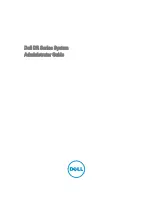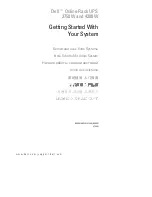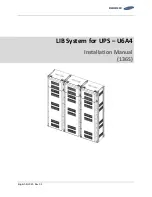
13
12
NETWORK/PHONE/FAX/MODEM PROTECTION CONNECTION
(OPTIONAL)
Connect a 10/100 Base-T network, single line phone, Fax or Modem line to the
RJ11/45 modular connectors on the rear panel of the UPS. This connection will
require another length of telephone or network cable. The cable coming from
the telephone service or networked system is connected to the port marked
“IN”. The equipment to be protected is connected to the port marked "OUT".
NOTE:
Connecting to the Network/Phone/Fax/Modem modular connectors is
optional. The UPS works properly without this connection.
COMMUNICATIONS PORT CONNECTION
(OPTIONAL)
The power monitoring software and interface cables can be used with the UPS.
Connect the interface cable (Serial or USB) to the appropriate communications
port on the rear panel of the UPS. Connect the other end of the cable to the device
that will be monitoring/controlling the UPS.
NOTE:
The SNMP card must be re-
moved before using the Serial or USB Communications ports. Connecting to the
Communications Port is optional. The UPS works properly without this connection.
CAUTION!
The TNV connector shall use the same type of RJ45.
CONNECTING THE UPS TO AN AC SOURCE
CAUTION
-
To reduce the risk of fire, connect only to a circuit provided with 20
amperes maximum branch circuit over-current protection in accordance with
the National Electric Code, ANSI/NFPA 70. Plug the UPS into a two pole, three
wire, grounded receptacle only. DO NOT PLUG THE UPS INTO EXTENSION
CORDS, ADAPTER PLUGS, SURGE STRIPS OR POWER STRIPS. DO NOT
CUT THE INPUT PLUG OFF AND ATTEMPT TO HARDWIRE THIS UPS, DO-
ING SO WILL VOID THE WARRANTY.
CHARGING THE BATTERY
The UPS will charge the internal batteries whenever the UPS is connected to
an AC source and there is an acceptable AC voltage present (90 - 150VAC). It
is recommended that the UPS's batteries be charged for a minimum of 4 hours
before use. The UPS may be used immediately, however, the “On Battery”
runtime may be less than normally expected. Typical battery life is 2 to 3 years.
Environmental factors do affect battery life. High temperatures, poor utility power,
and frequent, short duration discharges have a negative impact on battery life.
This
UPS has a temperature compensating charger. As the ambient temperature rises
the charger will reduce the voltage to prevent premature failures of the batteries.
NOTE:
If the UPS is going to be out of service or stored for a prolonged period of
time, the batteries must be recharged for at least twenty-four hours every ninety
days.
SNMP CARD
The
included SNMP Card is web based and is used for monitoring and control-
ling the UPS. See the SNMP Card's Manual for configuring and setting up the
SNMP Card.
NOTE:
Connecting to the SNMP Card is optional. The UPS works
properly without this connection.
SYSTEM OVERVIEW
This Line-Interactive UPS protects computers, servers, telecom systems, VoIP sys-
tems, security systems, and a variety of electronic equipment from blackouts, brown-
outs, overvoltages, and surges. The AVR function continuously corrects the voltages,
in-between the brownout and overvoltage transfer points (90 - 150VAC), to a safe usable
level. When the UPS is operating in the AVR mode the audible alarm will remain silent
and the AC normal mode indicator will blink. During normal AC operation, the UPS will
quietly and confidently protect your system from power anomalies.
The UPS will charge the batteries with the UPS in the on or off position when the UPS is
plugged into the wall outlet and there is an acceptable AC voltage present (90 - 150VAC).
This UPS has a temperature compensating charger. As the ambient temperature rises
the charger will reduce the voltage to prevent premature failures of the batteries. When
a blackout, brownout, or an overvoltage condition occurs; the UPS will transfer to the
battery mode, the Battery mode LED will illuminate and the audible alarm will sound
once every five seconds indicating that the commercial power is lost or unacceptable.
When the commercial power returns or is at an acceptable level, the UPS will automati-
cally transfer back to the AC normal mode and start recharging the batteries. During an
extended outage when there is approximately two minutes of backup time remaining the
audible alarm will sound twice every five seconds. This Low Battery Warning is inform-
ing the user that they should save all open files and turn off their computer. When the
batteries reach the predetermined level the UPS will automatically shutdown protecting
the batteries from over discharging. Once the commercial power returns the UPS will
automatically restart, providing safe usable power to the connected equipment and start
recharging the batteries.
TURNING THE UPS ON / OFF
To turn the UPS on: press and hold the On/Off/Test Button until the alarm sounds one
beep and then release. The UPS will perform a five second internal self-test. Once the
UPS has passed its internal self-test the UPS will provide an output and the load will be
powered. To turn the UPS off: press and hold the On/Off/Test Button until the alarm
sounds one beep and then release.
Block Diagram of the Basic Wiring and Internal Circuit Configuration
Summary of Contents for ERS1500RTNC
Page 15: ...27 26 Notes Notes...

































